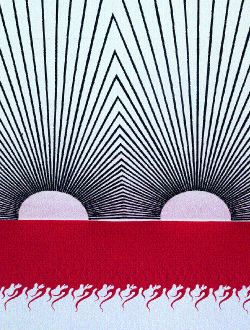Back to the Wall
The relief of reliefs: Richard Wright's wall paintings
The relief of reliefs: Richard Wright's wall paintings

Chancing upon one of Richard Wright's paintings for a second time is like the relief you might experience on bumping into a softly spoken acquaintance in a crowd. Then, just when you feel as if you had begun to connect, it disappears into thin air, leaving a ghostly after-image in the mind's eye that won't to go away - all wit, urbanity and enigma. Wright is an exponent of wall painting: a hybrid of painting and installation that has become something of a genre. It began in the mid-1960s when painting stepped off the canvas and onto the naked wall, and re-emerged in the early 1990s. But there's something terribly wrong with this attempt to locate Wright's work within the genre, since his paintings somehow make you forget that anyone ever had the idea of painting directly on the walls of interiors at all.
When you enter a room housing one of his works, for a split second it seems empty. Then you might notice a small patch of coloured pattern near the floor, or running up one edge of a corner. Occasionally you won't see it until you've turned around to leave. Reminiscent of sculpture or, perhaps more accurately, modest pieces of furniture or personal belongings, they occupy the room in a completely original way. Most 'wall painters' either use the room's dominant wall as a substitute for the stretched canvas (Sol LeWitt, Simon Patterson or Jessica Diamond, for example), or they cover each wall from floor to ceiling and corner to corner (Robert Barry, Michael Craig-Martin or Martin Boyce). Essentially, the former strategy derives from the mural; the latter from wallpaper. Wright's interventions tend to occupy very little of the total available wall space, often electing to work those parts of a gallery which no one in their right mind would choose, such as awkward thoroughfares outside the exhibition spaces themselves - stairwells, corridors, entrances.
When Wright does work in the gallery proper, he riffs off the eccentricities of the space and its door frames, skirting boards, alcoves, exit signs, pipes and shelving. Rooms with Rococo cornices don't seem to bother him (Inverleith House, Edinburgh, 1999); nor does beige floral embossed wallpaper (Belmont Hotel, Glasgow, 1995), stained concrete and scruffy windows (Luxembourg, 1998) or black rubber folding partitioning or views of obscene pink walls (Salon 3 in London's Elephant and Castle shopping centre, 1998). Sometimes the relationship between Wright's painting and a certain fixture gels to evoke a new figurative association. At TeclaSala in Barcelona in 1999 he painted four strips of what look like arabesque ironwork in blue and black, starting from just beneath a protruding pipe and ending just above the skirting board. The effect half-suggests a shower curtain, with the pipe standing in for the rail. The odd colour change from blue to black implies that the pipe is casting a slim area of shadow. By bringing the space's anomalies into play, Wright pulls off a paticularly sly version of institutional critique. While most other interventions tend to require, ironically, the authority of the most immaculate white cubes, Wright's additions bring out narratives of historical identity lurking beneath the matt emulsion of a given space.
Hence the very particular styles found in his motifs. Wright's predominantly abstract designs tend to fall into two categories: Modernist and Gothic. The latter manifests itself as Victorian Gothic, while his Modernism feels like the kind of delicate British thing the National Trust is now beginning to preserve, such as the De La Warr Pavilion in Bexhill-on-Sea. Often the two converge, as in his corner piece at the Drawing Center, New York, 1999, where a gothicky, quite sexual strip of red tendrils abutted a repeated ocular motif of radiating straight lines, or the Minimalist-style serialization of a spiky, hairy motif that ran across the top of one wall in the show 'Intelligence' (2000) at Tate Britain. As with Sarah Lucas' fatally crashed car, with which it was partnered, there was a suggestion of malevolence in Wright's piece, but in an obscure, occultish sense. This is evident elsewhere in his work, not just in the occasional use of a skull motif, but also in the blurred signification of spaced phrases delivered in the gilt script of medieval illumination: mathod (2000) and furkitoot (1998).
Very occasionally Wright paints small, illusionistic vignettes instead of flat patterns. One, executed at the Centrum Sztuki Wseolczesnej Zamek Ujazdowski, Warsaw, in 1998, is a carefully shaded monochrome picture of what looks like four Donald Judd shelf/seat furniture units. Another resembles a Naive artist's painting of a mirror-image landscape with castle tower. These works sit strangely alongside Wright's other wall paintings and their 1960s precursors. If anything, his practice puts me in mind of San Marco, the Florentine monastery where Fra Angelico and his assistants painted exquisite, sparse frescos of St Dominic with the crucifix in all 45 cells, each one a very slight variation on the master design. Perhaps it's partly Fra Angelico's serialized formalism that evokes the comparison: the vertical ribbons of red blood, the gold discs that stand for haloes, the spaced letters 'INRI', and the simple pink and turquoise frame motif that forms the perimeter of each image. Also, as with Wright, the ratio of white plaster to artist's painting is tipped dramatically in favour of the former, lending the art works an intense jewel-like aura while also enhancing the identity of the room itself. Jumping centuries, Wright's somehow hallowed and profane paintings turn galleries into living spaces, drawing out the subjective, the irrational, the domestic and the historical from rooms that are otherwise intended to signify the Modernist sophistries of neutrality, autonomy and transcendence.
























